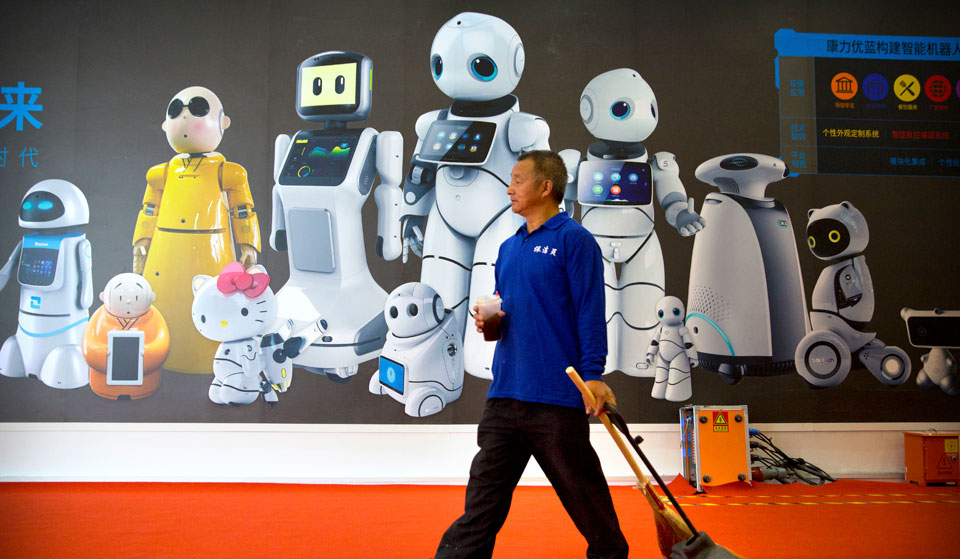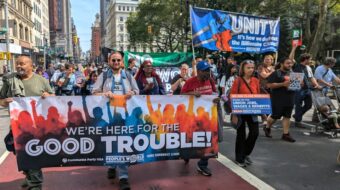
This is part 3 of the full main report, “Unity to save people and planet; For full equality, democracy, peace, and green socialism,” to the 31st National Convention of the Communist Party USA held in Chicago, Illinois, June 21-23, 2019. Other installments available here.
The abbreviated oral presentation is available here.
John Bachtell served as CPUSA national chair from 2014 to 2019. Rossana Cambron and Joe Sims were elected as the new CPUSA co-chairs.
Monopolization, and the crisis of wealth extremes
“We must make our choice. We may have democracy, or we may have wealth concentrated in the hands of a few, but we can’t have both.” – U.S Supreme Court Justice Louis Brandeis
Trump and the GOP trumpet what they claim is a record economic expansion creating a historically low unemployment rate.
“It’s never been better,” brags Trump. Indeed, it has never been better—for the rich. We live in the wealthiest country in the world, and the wealth produced by the exploited working class has flowed to the top .1%.
Working-class Americans live in a starkly different world. We are working harder and longer and falling further behind. We, along with our families and communities face fear and insecurity, battered by austerity, 40 years of wage stagnation, deindustrialization, union-busting, and the growth of low-wage service jobs, without benefits and retirement security.

Most wage growth is the result of states and municipalities raising the minimum wage.
In 1980, the top 1% earned, on average, 27 times more than the bottom 50%. Today, they make 81 times more.
Institutionalized racism and sexism compound income and wealth inequality. Black workers receive roughly 75% of what white workers receive. Women earn 80% of what men receive, while African-American women receive 61% of what white men receive. The difference is reaped by the boss in super-profits.
The official unemployment figures obscure the actual state of joblessness. Nearly 95 million Americans don’t participate in the production process, a labor participation rate of 62.5%. The real unemployment or underemployed rate is 37%. Millions have given up looking or work part-time and can’t find full-time jobs.
Unemployment among Black workers is twice that of white workers. Some Native American reservations report unemployment at 85%.
Most working families haven’t recovered from the Great Recession. Millions lost their life savings and homes. An ACLU study shows “by 2031, white household wealth will be 31% below what it would’ve been had the recession never happened. For black households, wealth will be 40% lower.”
Millions live by a thread, many working two or three jobs to put food on the table and a roof overhead. 60% can’t come up with $1,000 in an emergency, and half of older Americans have zero retirement savings.
Workers are working harder and are more productive, but household debt is 21% higher than it was in 2013 following the Great Recession, due to auto loan debt, the $1.5 trillion student loan burden, mortgages, and credit card debt.
Gig and part-time work are growing. Approximately 40% of the workforce is composed of contingent workers, i.e., temp agencies, on-call, contract workers, independent contractors, self-employed, and involuntary part-time (6.6 million).
Poverty rates—unchanged since the 1960s
Forty-one million Americans officially live in poverty, and 18 million live in extreme poverty. Poverty rates have barely changed since the 1960s. Due to institutionalized racism, 25% of Native Americans, 26% of Latinx people, and 27.7% of African Americans live in poverty.
Thirty percent of African-American children and 33% of Native American children live in poverty. About one-third of the 13 million children in poverty are white.
Areas of deep poverty also exist among white workers, mainly rural areas. Most who live in poverty work, including at Wal-Mart and Amazon, and many receive government assistance. Public school teachers in GOP-dominated states often visit food banks.
Most cities and towns have a vast and growing shortage of affordable housing. Over 500,000 people are homeless on any given night. You don’t have to travel far to see homeless tent communities under highway viaducts. Millions are being priced out of their homes and apartments because of rising property taxes and gentrification of working-class neighborhoods.
The Communist Party USA demands a national guaranteed living wage, massive construction of publicly- and cooperatively-owned affordable housing and federal rent protection laws.
Health care crisis
The Affordable Care Act (ACA) reduced the number of uninsured Americans from 44 million to 27 million Americans. But the ACA is under constant assault by the Trump administration and the GOP, and the uninsured population is increasing. Seventy million people are either uninsured or underinsured with high deductibles and co-payments.
Life expectancy is on the decline, including “death by despair” for middle-age whites by suicide, alcohol, and drugs.
Maternal deaths are rising. African-American, Native American, and Alaskan Native women suffer three times the maternal death rates as white women, reflecting institutionalized racism and sexism.
Infant mortality among African-American babies is near twice the rate for white babies. Overall, infant mortality is nearly double that of Cuba.
Working-class communities are being inundated by an opioid crisis destroying families, leaving grieving parents and children in its wake. Over 700,000 people died from drug overdoses between 1999 and 2017, 70% from opioids.
However, the pharmaceutical companies that peddle the opioids are reaping huge profits while health care services are slashed.
The CPUSA demands Medicare for All and placing the pharmaceutical industry under public authority.
The rich get much, much richer
These conditions are rooted in much deeper systemic processes taking place in global capitalism resulting in a crisis of wealth extremes, imbalances, instability, and crisis nodes.
Concentrated wealth is connected to wage stagnation, which, despite rising productivity, has been flat or declined in the past 40 years. As economist Thomas Piketty says, “the rise of the top 1% mirrors the fall of the bottom 50%.”
Monopolization, or the formation of oligopolies, and extreme wealth concentration are accelerating. This process is intrinsic to the system of capitalism and its drive for maximum profits; the system is incapable of reversing it.
The world’s eight richest people own wealth equal to the poorest half of the world’s population. 80% of the world’s population subsists on $2 a day.
In the U.S., the top 0.1% of Americans, our oligopoly, held 20% of the nation’s wealth in 2016 (up from 7% in 1979) and owned as much wealth as the bottom 90%.
The nation’s three wealthiest individuals—Bill Gates, Warren Buffett, and Jeff Bezos—collectively hold more wealth than the bottom 50% of the U.S. population. Roughly a fifth of Americans has zero or negative net worth.
According to Piketty, wealth accumulation is accelerating because the 1% control more of the economy. Witness the results of the 2017 Trump tax cuts for the rich. Wealth accumulation is exceeding economic growth and in the long term will lead to growing instability, the erosion of capitalist democracy, and economic insecurity.
At least 60 of the nation’s biggest corporations paid no federal income taxes in 2018 on a collective $79 billion in profits, the Institute on Taxation and Economic Policy says.
Besides, corporations receive public subsidies worth at least $110 billion a year, costing U.S. families about $6,000 each.
Wealth concentration is a threat to democracy under capitalism, especially with Citizens United, billionaire patrons of candidates, and the flood of ALEC-inspired legislation. This state of affairs led Supreme Court Justice Louis Brandeis to remark: “We must make our choice. We may have democracy, or we may have wealth concentrated in the hands of a few, but we can’t have both.”
Looming crisis and disruption from robotics and AI
A feature of capitalism is the constant revolutionizing of the means of production and the introduction of new technology, resulting in economic and social disruption.
The scientific and technological revolution has facilitated capitalist globalization and massive increases in productivity while causing economic dislocation and crises of under-consumption.
It has revolutionized everything, giving rise to just-in-time production and the gig economy.
Unjust trade agreements, shifting transnational corporate investments, and outsourcing to global low-wage zones have harshly impacted U.S. manufacturing employment and devasted working-class communities and entire regions.
However, corporate-authored trade pacts don’t tell the whole story. Obscured in all this, including by Trump’s economic nationalism and racist scapegoating, is the impact of automation.
In the past 25 years, a span that includes NAFTA and China’s entrance into the WTO, U.S. manufacturing output has increased 40%. U.S. workers are being exploited more than ever.
“America has lost more than 7 million factory jobs since manufacturing employment peaked in 1979. Yet American factory production…more than doubled (from 1979 to 2015),” reported the New Haven Register.

One study found “the vast majority of the lost jobs—88%—were taken by robots and other homegrown factors that reduce…labor.”
The Obama administration projected 47% of all jobs in the U.S. would be at risk of elimination due to automation by 2025.
If these forecasts are accurate, automation will create economic dislocation, disruption, and loss of jobs on an enormous scale, including 5.1 million over the next five years.
Transportation, sales, customer service, medical/healthcare, and legal fields will be most impacted.
Similarly, loss of coal mining jobs is due not to a “war on coal,” but to greater automation. Between 1980 and 2015, the coal industry shed 59% of mining jobs but production grew 8%.
Since 1997, 42% of jobs in the steel and metals industry has been eliminated, and production has grown by 38%. Five hundred thousand construction jobs will be lost in the next five years due to automation.
Outsourced industries, like the textile industry, are beginning to return to the U.S. But they are globally competitive because of automation.
The debate is ongoing whether this newest round of automation will have a significant impact on job loss. In the past, technological advances have also given rise to new industries, created millions of new jobs, and changed the composition of the workforce.
What’s different this time is artificial intelligence (AI), which is being applied to visual and voice recognition. Computers can now “think and learn” without humans.
While this is a crisis for capitalism, automation creates the material conditions and abundance for socialism and allows society to deal with disruptions without placing any burdens on the working class.
A green transition with large-scale infrastructure works and the reorganization of production is necessary to address the crises of climate change, wealth inequality, and automation and AI.
The Green New Deal would create millions of new jobs. To realize it will require a massive wealth redistribution, including funding a transition wage, free education, and healthcare, a shorter work week with substantial wage increases, sizeable public investment, and a massive transfer of funds from the military budget.
But it starts with a defeat of Trump, the GOP, and extreme right in the 2020 elections.
Continued in part 4: The political and democratic crisis










